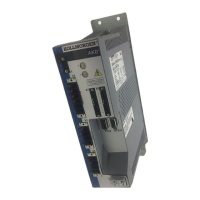AKD CANopen | 8 Appendix
8.2 Examples
8.2.1 Examples, setup
All examples are valid for the AKD. All values are hexadecimal.
8.2.1.1 Basic testing of the connection to the AKD controls
When the AKD is switched on, a boot-up message is transmitted over the bus. The telegram continues to be
transmitted, as long as it has not yet found a suitable receiver in the bus system.
If a CAN master is unable to recognize this message, then the following measures can be taken to test com-
munication:
l Check the bus cable: correct characteristic impedance, correct termination resistors at
both ends?
l With a multimeter: check the quiescent level of the bus cables CAN-H and CAN-L against CAN-GND
(approx. 2.5 V).
l With an oscilloscope: check the output signals on CAN-H and CAN-L at the AKD. Are
signals being transmitted on the bus? The voltage difference between CAN-H and CAN-L for a logical "0" is
approx. 2-3 V.
l Does signal transmission stop if the master is connected?
l Check the master hardware.
l Check the master software!
138 Kollmorgen™ | November 2012

